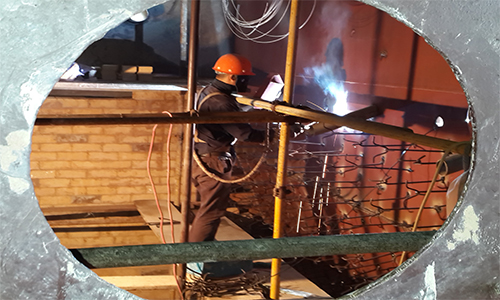Rotary Garbage Incinerator
Rotary garbage incinerator is mainly used to process industrial garbage. Rotary industrial garbage incinerator is composed of rotary furnace main body, waste suppy equipment, driving equipment, fuel burner, first and secondary air supply equipment, secondary combustion furnace, etc. At its back side, incinerator grate and ash transportation machine is equipped, secondary combustion gas blowing equipment is at the top. When garbage is loaded into rotary incinerator, it is gradually delivered from low temperature zone to high temperature zone by rotating force and gravity, and the incineration finished during the process.
Rotary garbage incinerator is mainly designed for teat large size garbage and industrial waste, it can process various kinds of solid waste, sewage sludge, viscous mateails( such as heavy oil, tar, pitch, coating material slag, etc) and plastic. The incineration temperature is about 900℃, secondary combustion furnace temperature is about 1100~1200℃.
Rotary Garbage Incinerator Refractory
At garbage loading part, the mechanical abrasion and impact is severe, meanwhile, the temperature fluctuation is large, so refractory materials should have good wear resistance and thermal shock resistance, fireclay bricks can be adopted here.
In drying chamber and combustion chamber, garbage directly contact with furnace lining at high temperature, at one hand, furnace slag will adhere to furnace lining, at the other hand, impurities will also permeate into furnace ling, the charging of garbage will also cause temperature change, so refractory material should not only have good wear resistance, corrosion resistance and coating resistance, but also should have good alkali corrosion resistance and oxidization resistance. So, fireclay bricks, high alumina bricks, castable and plastic refractory are often used here.
At tube and air cooling part, refractory suffers water spraying, impurity corrosion and temperature change, so alkali proof, water proof and thermal shock proof catable can be used here.
In rotary furnace, garbage continuously rotates in the furnace, and temperature changes frequently due to garbage loading, so clay bricks, high alumina bricks, SiC bricks, or high alumina castable, SiC castable are usually adopted here.
All in all, shaped refractory used in rotary garbage incinerator includes fireclay bricks, high alumina bricks, silicon carbide bricks, unshaped refractory used in rotary garbage incinerator includes fireclay castable, high alumina castable, silicon carbide castable, chamotte plastic mix, high alumina plastic mix, etc.
Rotary Incinerator Roasting
Rotary furnace should be roasted by wood, furnace temperature should be controlled at 30~50℃. 7 days later, fuel oil is used for the roasting of furnace. Temperature raising speed is 5~10℃/h, when temperature reaches to 100℃, the temperature is held stable for 3 days, then the temperature is increased to 300℃ at the speed of 5~10℃/h, the temperature is also kept stable for 3 days. At last, the furnace is heated to 450℃ at the speed of 5~10℃/h, the temperature is kept for 2 days and then decreased to room temperature, the roasting is finished. When roasting the furnace, if the furnace temperature is below 100℃, the furnace shouldn’t rotate. When the furnace temperature is higher than 100 ℃, the furnace rotates at the speed of 90°/h. When temperature is above 300℃, the furnace rotates 180°/h. When the temperature reaches to 450℃, furnace rotates at the min. speed of 0.3r/min, so the strength of the lining can be promised and won’t deform during using.
Rotary Garbage Incinerator Operation Attentions
Waste materials processed by petrochemical factories are diverse, they are not in onefold form, but no matter the waste is in solid state, fluid state or gas state, the substantial question of the incineration is combustion. So the following items should be paid attention to during the working of incinerator.
The adaption to waste of the incinerator. The wider the adaptation to waste of the incinerator, the better, for example, rotary furnace and fluidized bed incinerator has good adaption t waste incineration. But it is not always the case, tests must be carried out before putting different kinds of waste materials in one incinerator, or the normal operation would be affected.
The service life of the incinerator. The service life of the incinerator relies on the service life of the lining. When the lining is casted or brick lined, and the furnace is roasted, it should not be put into production at once. When the furnace is in formal operation, the temperature can be raised at the speed of 20℃/h, when it reaches to 650℃,it is maintained for 12h, then it is heated to the working temperature(800~1000℃) at the rate of 20℃/h, then materials can be loaded into it for incineration, tests suggested that it is beneficial for prolonging furnace life.
Charging and working temperature control. When furnace temperature reaches to certain degree, material charging quantity is 1/3 ~1/4 that of normal quantity, the loaded material should evenly distributed on the combustion bed, without packing. Both over high and over low working temperature can cause secondary environment pollution. The exhaust after waste incineration should meet national emission standards. To properly control operation temperature, the flame length of auxiliary burner must be controlled under 2/3 of that in the furnace.
Operation members’ safety must be secured, the incinerated materials all contain toxic compositions and shouldn’t contact with human body. Workers should also pay attention to high temperature furnace shell scald, the furnace hearth is kept slightly negative atmosphere operation.
The inner part and outer part of incinerator should often cleaned and keep neat, combustible and explosive materials should not be stored at the surrounding of the furnace.
Before shutting down, material charging should be stopped first, then combustor should be stopped, it can avoid the unburned odor or black smoke generated in the combustor discharging into air.

